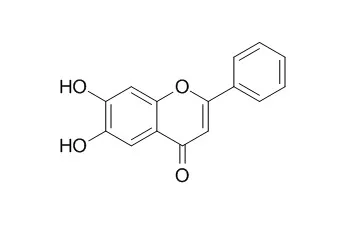| In vitro: |
| Quantitative Structure Activity Relationships, 2000, 19(1):50-53. | | Theoretical Investigation on Free Radical Scavenging Activity of 6,7‐Dihydroxyflavone.[Reference: WebLink] |
METHODS AND RESULTS:
The difference of heat of formation between parent molecule and its free radical (ΔHOF), calculated by semiempirical quantum chemical method AM1, was employed as a theoretical index to characterize the O–H bond dissociation energy (BDE) of antioxidant. Through a comparison between ΔHOF of model molecules, it was found that 6,7‐dihydroxyflavone (DHF) possessed two favorable structural factors, the presence of ortho hydroxyls and the existence of para oxygen, to weaken its O–H bond at position 6, but the passive effect produced by electron‐withdrawing property of the chromonoid ring C surpassed the active effect of the para oxygen. Therefore the free radical scavenging activity of DHF was lower than that of quercetin which possessed catecholic hydroxyl in ring B and was scarcely influenced by ring C.
CONCLUSIONS:
As a result of the analysis, two more active flavonoid antioxidants were constructed theoretically. | | Antimicrobial Agents and Chemotherapy, 01 Apr 2004, 48(4):1357-1360. | | 6,7-Dihydroxyflavone Dramatically Intensifies the Susceptibility of Methicillin-Resistant or -Sensitive Staphylococcus aureus to -Lactams.[Reference: WebLink] |
METHODS AND RESULTS:
We have demonstrated that 6,7-Dihydroxyflavone by itself has only a weak antibacterial effect on methicillin-resistant Staphylococcus aureus (MRSA) but that at concentrations less than MIC it synergistically elevates the susceptibility of clinically isolated MRSA and methicillin-sensitive S. aureus strains to beta-lactam antibiotics from 8- to 32,800-fold. |
|






 Cell. 2018 Jan 11;172(1-2):249-261.e12. doi: 10.1016/j.cell.2017.12.019.IF=36.216(2019)
Cell. 2018 Jan 11;172(1-2):249-261.e12. doi: 10.1016/j.cell.2017.12.019.IF=36.216(2019) Cell Metab. 2020 Mar 3;31(3):534-548.e5. doi: 10.1016/j.cmet.2020.01.002.IF=22.415(2019)
Cell Metab. 2020 Mar 3;31(3):534-548.e5. doi: 10.1016/j.cmet.2020.01.002.IF=22.415(2019) Mol Cell. 2017 Nov 16;68(4):673-685.e6. doi: 10.1016/j.molcel.2017.10.022.IF=14.548(2019)
Mol Cell. 2017 Nov 16;68(4):673-685.e6. doi: 10.1016/j.molcel.2017.10.022.IF=14.548(2019)